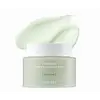What's inside
What's inside
 Key Ingredients
Key Ingredients

 Benefits
Benefits

 Concerns
Concerns

 Ingredients Side-by-side
Ingredients Side-by-side

Cetyl Ethylhexanoate
EmollientCaprylic/Capric Triglyceride
MaskingPolyglyceryl-6 Caprate
CleansingPolyglyceryl-10 Diisostearate
EmulsifyingSynthetic Wax
AbrasiveCaprylyl Glycol
EmollientSimmondsia Chinensis Seed Oil
EmollientEthylhexylglycerin
Skin ConditioningWater
Skin ConditioningButylene Glycol
HumectantMelia Azadirachta Leaf Extract
Skin ConditioningMelia Azadirachta Flower Extract
Skin ConditioningCoccinia Indica Fruit Extract
Skin ConditioningVitis Vinifera Fruit Extract
Skin ConditioningSolanum Melongena Fruit Extract
Skin ConditioningPyrus Malus Fruit Extract
Skin ConditioningPrunus Mume Fruit Extract
HumectantCarica Papaya Fruit Extract
Skin ConditioningAmber Powder
Ocimum Sanctum Leaf Extract
Skin ConditioningCurcuma Longa Root Extract
MaskingMoringa Oleifera Seed Oil
EmollientCorallina Officinalis Extract
Skin ConditioningPolyglyceryl-6 Polyricinoleate
EmulsifyingPolyglyceryl-6 Caprylate
EmulsifyingPolyglyceryl-4 Caprate
EmulsifyingPolyglyceryl-3 Cocoate
EmulsifyingMelaleuca Alternifolia Leaf Water
AntimicrobialMelaleuca Alternifolia Leaf Extract
Perfuming4-Terpineol
MaskingCetyl Ethylhexanoate, Caprylic/Capric Triglyceride, Polyglyceryl-6 Caprate, Polyglyceryl-10 Diisostearate, Synthetic Wax, Caprylyl Glycol, Simmondsia Chinensis Seed Oil, Ethylhexylglycerin, Water, Butylene Glycol, Melia Azadirachta Leaf Extract, Melia Azadirachta Flower Extract, Coccinia Indica Fruit Extract, Vitis Vinifera Fruit Extract, Solanum Melongena Fruit Extract, Pyrus Malus Fruit Extract, Prunus Mume Fruit Extract, Carica Papaya Fruit Extract, Amber Powder, Ocimum Sanctum Leaf Extract, Curcuma Longa Root Extract, Moringa Oleifera Seed Oil, Corallina Officinalis Extract, Polyglyceryl-6 Polyricinoleate, Polyglyceryl-6 Caprylate, Polyglyceryl-4 Caprate, Polyglyceryl-3 Cocoate, Melaleuca Alternifolia Leaf Water, Melaleuca Alternifolia Leaf Extract, 4-Terpineol
Cetyl Ethylhexanoate
EmollientTriethylhexanoin
MaskingPEG-20 Glyceryl Triisostearate
EmollientCellulose
AbsorbentSynthetic Wax
AbrasiveCaprylic/Capric Triglyceride
MaskingCitrus Aurantium Dulcis Peel Oil
MaskingWater
Skin Conditioning1,2-Hexanediol
Skin ConditioningCaprylyl Glycol
EmollientLavandula Angustifolia Oil
MaskingMyristica Fragrans Extract
MaskingTocopherol
AntioxidantButylene Glycol
HumectantCitric Acid
BufferingGluconolactone
Skin ConditioningHydrolyzed Hyaluronic Acid
HumectantLactobionic Acid
BufferingPanthenol
Skin ConditioningOryza Sativa Extract
AbsorbentLimonene
PerfumingLinalool
PerfumingCetyl Ethylhexanoate, Triethylhexanoin, PEG-20 Glyceryl Triisostearate, Cellulose, Synthetic Wax, Caprylic/Capric Triglyceride, Citrus Aurantium Dulcis Peel Oil, Water, 1,2-Hexanediol, Caprylyl Glycol, Lavandula Angustifolia Oil, Myristica Fragrans Extract, Tocopherol, Butylene Glycol, Citric Acid, Gluconolactone, Hydrolyzed Hyaluronic Acid, Lactobionic Acid, Panthenol, Oryza Sativa Extract, Limonene, Linalool
 Reviews
Reviews

Ingredients Explained
These ingredients are found in both products.
Ingredients higher up in an ingredient list are typically present in a larger amount.
Butylene Glycol (or BG) is used within cosmetic products for a few different reasons:
Overall, Butylene Glycol is a safe and well-rounded ingredient that works well with other ingredients.
Though this ingredient works well with most skin types, some people with sensitive skin may experience a reaction such as allergic rashes, closed comedones, or itchiness.
Learn more about Butylene GlycolThis ingredient is an emollient, solvent, and texture enhancer. It is considered a skin-softener by helping the skin prevent moisture loss.
It helps thicken a product's formula and makes it easier to spread by dissolving clumping compounds.
Caprylic Triglyceride is made by combining glycerin with coconut oil, forming a clear liquid.
While there is an assumption Caprylic Triglyceride can clog pores due to it being derived from coconut oil, there is no research supporting this.
Learn more about Caprylic/Capric TriglycerideCaprylyl Glycol is a humectant and emollient, meaning it attracts and preserves moisture.
It is a common ingredient in many products, especially those designed to hydrate skin. The primary benefits are retaining moisture, skin softening, and promoting a healthy skin barrier.
Though Caprylyl Glycol is an alcohol derived from fatty acids, it is not the kind that can dry out skin.
This ingredient is also used as a preservative to extend the life of products. It has slight antimicrobial properties.
Learn more about Caprylyl GlycolCetyl Ethylhexanoate is an emollient ester. It comes from cetearyl alcohol and 2-ethylhexanoic acid.
Cetyl Ethylhexanoate is an emollient that adds a velvety feel to skin without being greasy or oily. Emollients help trap moisture into your skin, keeping your skin soft and hydrated.
Synthetic Wax is created from fossil fuels such as natural gas. It is used to enhance texture, adjust pH, and as an occlusive.
It may also be used as an abrasive ingredient to exfoliate the skin.
Synthetic Wax may not be fungal acne safe.
Learn more about Synthetic WaxWater. It's the most common cosmetic ingredient of all. You'll usually see it at the top of ingredient lists, meaning that it makes up the largest part of the product.
So why is it so popular? Water most often acts as a solvent - this means that it helps dissolve other ingredients into the formulation.
You'll also recognize water as that liquid we all need to stay alive. If you see this, drink a glass of water. Stay hydrated!
Learn more about Water